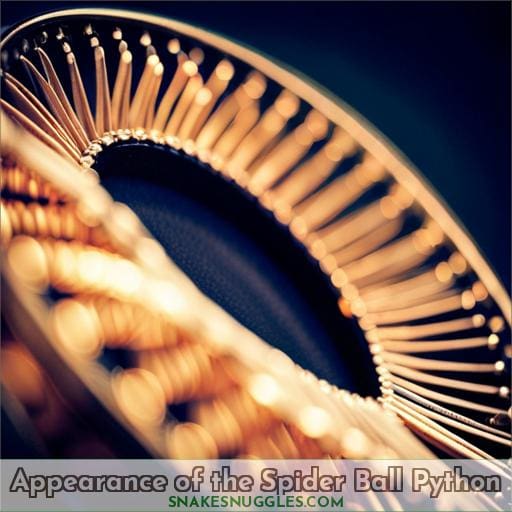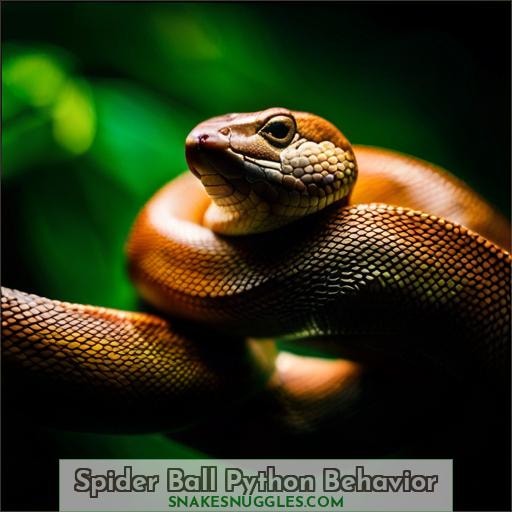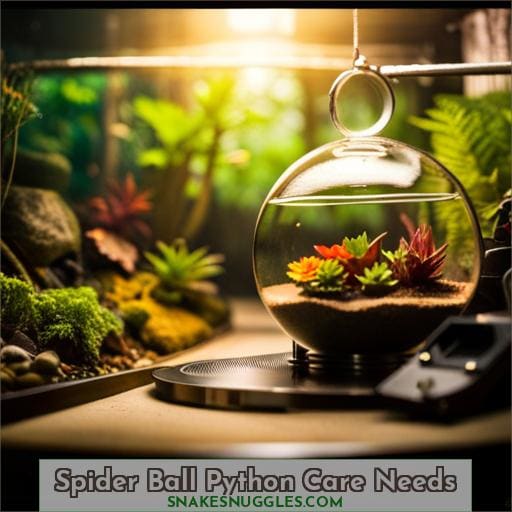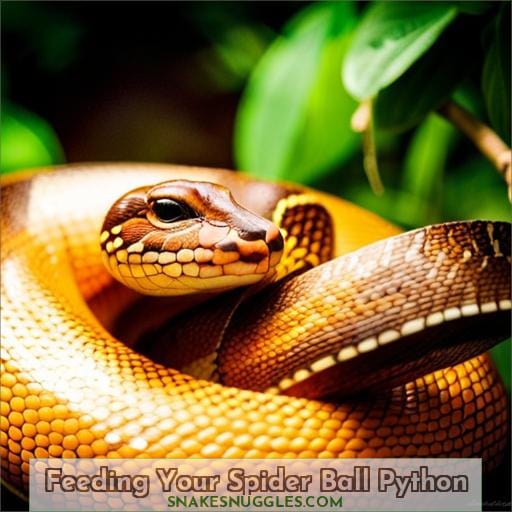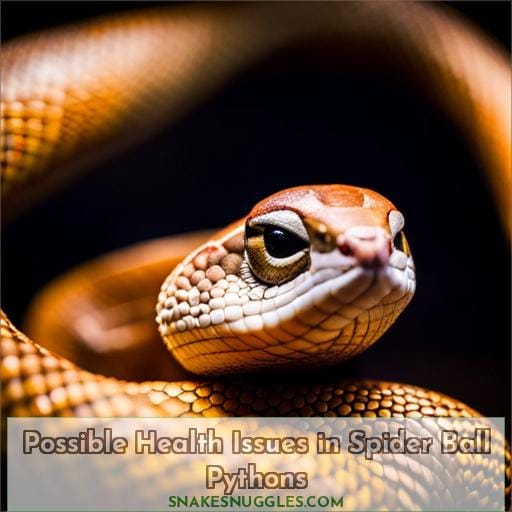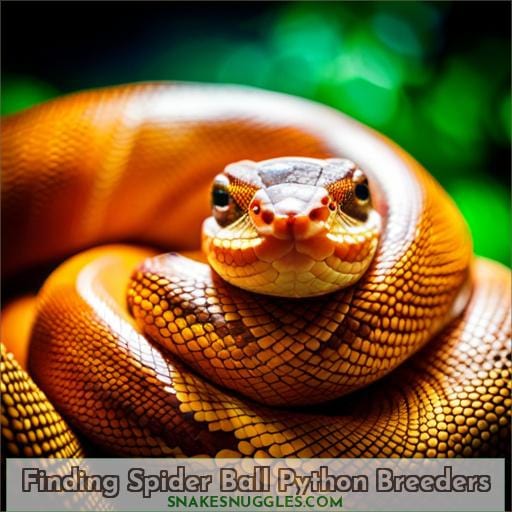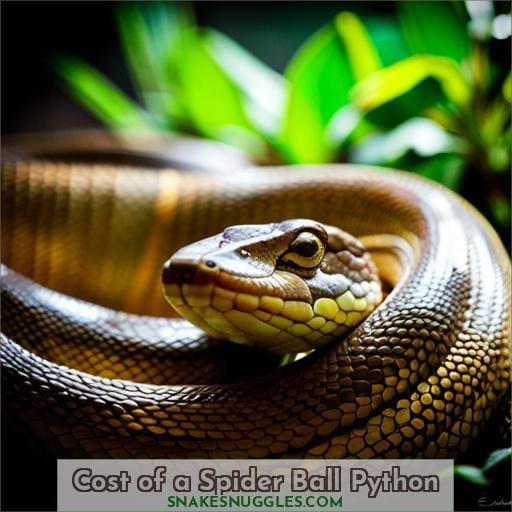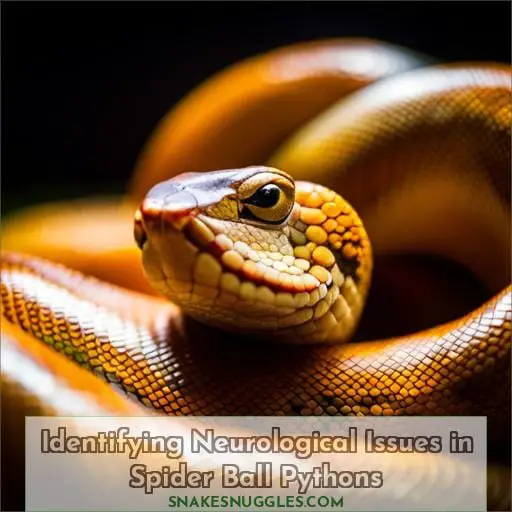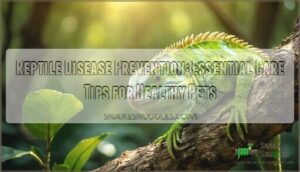This site is supported by our readers. We may earn a commission, at no cost to you, if you purchase through links.
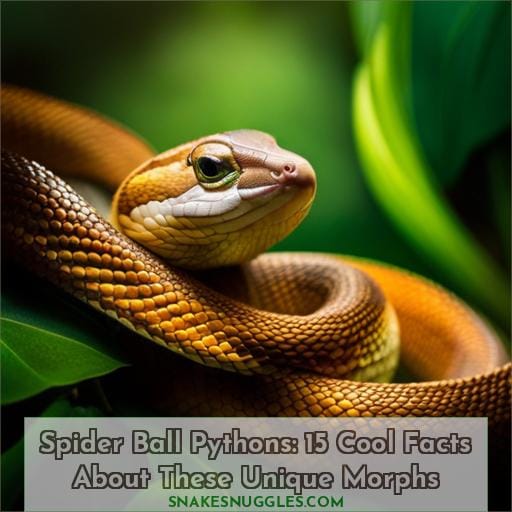 Sixty percent of spider ball pythons exhibit neurological issues.
Sixty percent of spider ball pythons exhibit neurological issues.
Yet, their intricately webbed patterning still captivates reptile enthusiasts.
These unique morphs, first bred in 1999, showcase an array of brown, yellow, and black hues with elongated stripes that resemble a spider’s web across their bodies.
Though they require particular care and some have health problems, their coloring and behaviors tell a fascinating story that both newcomers and experts can appreciate.
Table Of Contents
- Key Takeaways
- Appearance of the Spider Ball Python
- Spider Ball Python Behavior
- Spider Ball Python Care Needs
- The Genetics Behind the Spider Morph
- Feeding Your Spider Ball Python
- Possible Health Issues in Spider Ball Pythons
- Finding Spider Ball Python Breeders
- Cost of a Spider Ball Python
- Popular Spider Ball Python Morph Combos
- Identifying Neurological Issues in Spider Ball Pythons
- Frequently Asked Questions (FAQs)
- Conclusion
Key Takeaways
- Spider ball pythons have a unique spiderweb patterning resulting from genetic mutations first discovered in 1999.
- 60% of spider ball pythons exhibit mild neurological issues like head wobbling, corkscrewing motions, or sensitivity to abrupt changes.
- Proper spider ball python care requires maintaining ideal temperature gradients and humidity levels, using appropriate substrates, providing hiding spots, and limiting stress from overhandling.
- Spider genes are dominant and result in stunning designer morphs when bred with other ball python varieties, but responsible breeders aim to understand associated neurological conditions.
Appearance of the Spider Ball Python
Among you, the Spider Morph stands out with its distinctive elongated, wavy stripes reminiscent of a spider’s web across its rich brown, creamy yellow, and deep black smooth scales.
Average lengths span 3-4 feet with muscular, robust bodies.
Heads take on a distinct triangular shape with a prominent jawline that appears small relative to their bodies.
Color variations run the gamut from deep blacks to rich browns to creamy yellows in captivating spider web-like patterns.
Genetic combinations with other morphs result in even more remarkable appearances.
Whether in genetic isolation or combined with other morphs, the spider ball python’s unique patterning and color variations make them truly stand out visually.
Their unique aesthetics explain much of this morph’s popularity among breeders and collectors seeking eye-catching specimens.
Spider Ball Python Behavior
While spider ball pythons tend to be mild-mannered, their behavior may show some effects from the spider gene, like a slight head wobble or sensitivity to abrupt changes.
These genetic variations can lead to unusual behaviors like corkscrewing or flipping their heads.
Spider balls may also face feeding challenges compared to normal ball pythons.
As shared on reptile forums, owners report balls twisting their necks when striking prey or even turning red during feeding.
With proper care and maintenance of ideal temperatures and humidity, spider morphs can thrive despite their genetic quirks.
Experienced keepers caution that these snakes may be more prone to stress and require gentle handling as well as consistency in their husbandry routine.
Overall, spider balls display their own unique traits traceable to genetics but can still make delightful pets when their special needs are met.
Spider Ball Python Care Needs
You’ll need to provide an appropriately sized and secure terrarium with a secure lid for your spider ball python.
Maintain proper temperature gradients from the 80s on the warm end to the 70s on the cool end, along with 50-70% humidity.
Use substrates like aspen shavings or cypress mulch.
Despite their mild temperament, limit handling to reduce stress.
Provide hiding spots and explore new enrichments.
Feed an appropriately sized rodent every 5-7 days for juveniles, 7-10 days for adults.
Consider scenting techniques if they’re picky eaters.
When possible, explore genetic pairings with other morphs to produce unique spider combos like bumblebees, pandas, and axanthics.
Monitor for signs of the spider wobble.
Overall, focus on reducing stress and meeting their basic husbandry needs.
The Genetics Behind the Spider Morph
The spider gene is a dominant mutation that causes the unique spiderweb patterning when just one copy of the gene is present.
When bred with other ball python morphs, the spider gene displays co-dominance, resulting in a diversity of appearances in the offspring.
Combinations with morphs like pinstripe, pastel, and banana can create captivating visual effects.
However, the spider gene has been associated with neurological conditions in some individual snakes, causing slight tremors of the head and body known as the spider wobble.
Responsible breeders are working to understand this connection and navigate breeding challenges.
Overall, the intricate genetics of the spider morph allow for stunning and unique designer morphs, but also require diligent monitoring for neurological sensitivity.
Feeding Your Spider Ball Python
Although the genetics behind their unique markings are fascinating, you’re going to need to properly feed your spider ball python if you want it to remain healthy.
- Match prey size to the thickness of the snake’s body.
- Spiders may require scenting techniques or live prey due to their sensitive nature.
- Monitor feeding behavior closely.
- Neurological issues may cause difficulty striking or constricting prey.
- Provide assistance if needed.
- Ensure optimal temperature and humidity gradients.
- Inadequate husbandry can negatively impact feeding and digestion.
- Expect some irregular behavior like rolling onto their backs while eating.
- Genetic variations lead to neurological and behavioral quirks.
Possible Health Issues in Spider Ball Pythons
| Symptom | Possible Cause | Action |
|---|---|---|
| Head wobble | Neurological defect from spider gene | Ensure proper temperatures and humidity |
| Refusing food | Stress, prey too large | Try smaller prey items |
| Poor sheds | Low humidity | Increase humidity, soak snake |
| Corkscrewing | Neurological defect | Consult exotic veterinarian |
| Star gazing | Normal behavior | None needed |
While the root cause of some symptoms may be the spider gene itself, focus on optimizing their environment through proper temperatures, humidity levels, hide spots, and habitat size.
Work with an experienced reptile veterinarian if symptoms persist or worsen over time. Genetic issues like the wobble may be unavoidable, but quality husbandry and care make a big impact.
Finding Spider Ball Python Breeders
To find reputable spider ball python breeders, start by researching online reptile forums and social media groups.
Look for breeders who specialize in spider morphs and have recommendations from other owners.
Pay attention to genetic pairings they work with, as reputable breeders focus on health and behavior rather than novelty.
Check for regular updates on availability and pricing trends.
Quality breeders openly discuss breeding challenges like the spider wobble.
Ask if they follow protocols to maximize hatchling health.
Consider only those willing to answer questions on feeding, housing, handling, and more.
A commitment to education and conservation helps ensure an ethical, sustainable spider ball python population.
Favor those active in advancing the understanding of spider genetics over mass production.
Cost of a Spider Ball Python
Expect to pay $100-300 for a normal spider ball python morph, with rarer combos commanding higher prices.
The cost can vary depending on factors like genetics, breeder reputation, age, and location.
Rare trait combinations with the spider gene, like albino or pinstripe, can cost $500-1,000+.
Older, established breeders tend to charge more than newcomers.
Prices also depend on supply and demand in your geographic area.
When reviewing breeders, ensure they follow ethical breeding practices and produce healthy animals.
Costs may decline as the morph becomes more common, following typical market trends.
Overall, the spider trait remains moderately priced thanks to steady production, making these unique snakes accessible to many hobbyists.
Popular Spider Ball Python Morph Combos
Your spider banana and spider pinstripe combos display alluring blended patterns from pairing the dominant spider gene.
When mixed with other dominant morphs like pastel or mojave, the results highlight the intricacies of spider genetics through unique pairings.
Using specialized breeding techniques to achieve greater morph diversity requires an understanding of potential neurological traits in some offspring.
However, the rewards of exploring new combo possibilities and propagating gorgeous designer snakes can outweigh the challenges.
As long as responsible breeding practices are followed, the spider gene will likely continue to be popular for producing one-of-a-kind ball pythons with spectacular labyrinth and striped patterns.
Identifying Neurological Issues in Spider Ball Pythons
While the spider morph’s namesake patterning may be striking, this dominant gene carries an unfortunate downside – neurological abnormalities colloquially termed the spider wobble.
Careful observation of your snake’s behaviors, from feeding to exploring its enclosure, can help identify symptoms. Corkscrewing, flipping, star gazing, and repetitive movements may indicate neurological problems.
Vet exams and testing help differentiate wobble from other conditions. If diagnosed, focus on maintaining ideal temperatures, humidity, hides, and minimal stimuli to reduce stress-exacerbated symptoms.
Genetic implications must be considered if breeding spider pythons; work only with responsible breeders carefully selecting pairings to promote healthier lineages.
With attentive husbandry and veterinary guidance, spider ball pythons can lead enriched, comfortable lives despite their genetic quirk.
Frequently Asked Questions (FAQs)
How big do spider ball pythons get?
Spider ball pythons typically reach an average adult length of 3 to 4 feet.
Their growth rate and maximum size depend on factors like genetics, feeding regimen, and overall health over their 15+ year lifespan.
Provide proper husbandry to support their growth and development.
What is the lifespan of a spider ball python?
The lifespan of a spider ball python is typically around 20 to 30 years, resembling the longevity of an ancient redwood tree.
With proper care and husbandry, these remarkable creatures can provide companionship for decades.
Can I house spider ball pythons together?
No, you shouldn’t house multiple spider ball pythons together.
Are spider ball pythons legal to own where I live?
Unfortunately, providing definitive legal advice would be irresponsible without knowing your specific location.
I suggest researching your state and local exotic pet laws regarding spider ball pythons to determine if they’re allowed where you live.
Reach out to local herpetological societies if you need help interpreting regulations.
What accessories do I need for a spider ball python enclosure?
When setting up an enclosure for your spider ball python:
- Focus on providing proper heating, humidity, hides, and substrates to meet their basic needs and reduce stress.
- Prioritizing their health and comfort will lead to a thriving pet.
Conclusion
You gaze at these intricately patterned pythons, marveling at their striking beauty.
Yet concern equally captivates you as you ponder potential health issues.
Still, their rarity entices.
So move forward judiciously, ever informing yourself, providing attentive care of spider ball pythons’ specialized needs.
Together, intricacy and responsibility intertwine, much like the gossamer threads gracing these fascinating pythons’ skins.

